Simulation of a Circular Design (CD) Detector
This detector represents the detectors for the fission fragments. The detector is segmented in r and phi and the outputs in ROOT are stored separately for r and phi. In other words, events stored from the radial segments will begin with CDu and CDv for the angular segments (examples will be given later on). All properties of the detector should be changeable from the command line by passing additional arguments to each detector. The detectors default parameter values should correspond to the S3 design. A visual representation of the detector in GEANT4 is shown below.
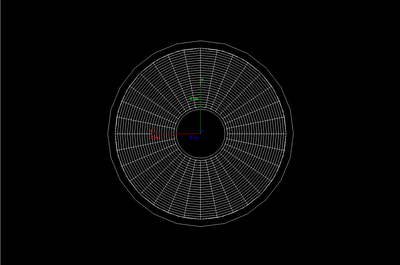
Help text in ggland
By typing ./land_geant4 --cd=help you'll get the following output:
Parse: cd
Circular Design (CD) detector with an active area of Si.
The active area is divided into segments in r and phi.
Default design: S3 from Micron Semiconductor Ltd.
rot{x,y,z}|x0|y0|z0 0 1|cm Rotation | Location. (Cumulative.)
rmin 1 cm Inner radius of CD detector.
rmax 3.8 cm Outer radius of CD detector.
activermin 1.1 cm Inner radius of CD active area.
activermax 3.5 cm Outer radius of CD active area.
thickness 0.0061 cm Full thickness (dz) of CD.
deadlayer 5e-05 cm Dead layer in z of detector.
strips_r 24 Number of rings (radial segments).
strips_phi 32 Number of sectors (phi segments).
type Si Detector material.
simple 0 Simplify output to tree.
enter 0 Include incoming particles in tree.
sigma_x 0.005 cm x blurring in tree output.
sigma_y 0.005 cm y blurring in tree output.
sigma_e 0.035 e blurring in tree output.
noblur Do not randomise clusterized
x,y,z,t,e output.
spec=DET-ABC With specification of DET-ABC,
location not taken, given explicitly.
inside=DET-ABC Inside root volume of DET-ABC.
tree-sort-by-t Sort clusters by time instead of decreasing energy.
tree-num-clusters=N Number of clusters to include (default 10).
tree-max-cluster=N Maximum length of a cluster (default 10 cm).
tree-cluster-coord=[world|det|seg] Cluster coordinate (default det).
tree-keep-cluster-prob=[I=]P Prob. to keep cluster (per subvolume I).
tree-keep-event-prob=[I=]P Prob. to keep all clusters (per subvolume I).
tree-gun-edep Record total deposited energy for each primary.
tree-name=NAME Override default name.
These are all the parameters that can be changed, with their default values and a short description of each parameter. Always refer to the ggland output for an updated description, not the copy above.
Using the CD Detector
A simple script to generate some output to a root file:
./land_geant4 --cd=z0=2cm\
--gun=box,sdx=8cm,sdy=8cm,p,T=10MeV \
--world=type=vacuum --events=50000 \
--tree=digi,test.root
This will place the detector 2 cm from the target. Note that the digi option is included for the --tree to use the detector's digitizer. (The gun is just something that makes sure we get hits on the detector.) The detector stores energy, x,y positions and an index by default; once for the radial segments (beginning with CDu) an once for the angular segments (CDv). If the digitizer option is set, the root file will also contain the digitizer energy and corresponding index, again once for both radial (CDud) and angular (CDvd) segments.We can for example plot Draw("CDuy:CDux") to get all hits detected on the radial segments. All plots on this page is generated with the above script, but using 500000 events instead for clearer images.
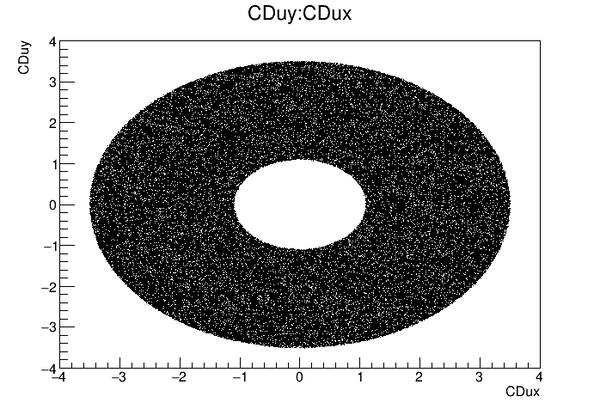
(The same picture would be obtained if we instead plot "CDvy:CDvx" instead.) If we want to plot a specific ring we add a condition on the index, e.g. Draw("CDuy:CDux","CDui==2") for the second ring, counting from the origin and outwards.
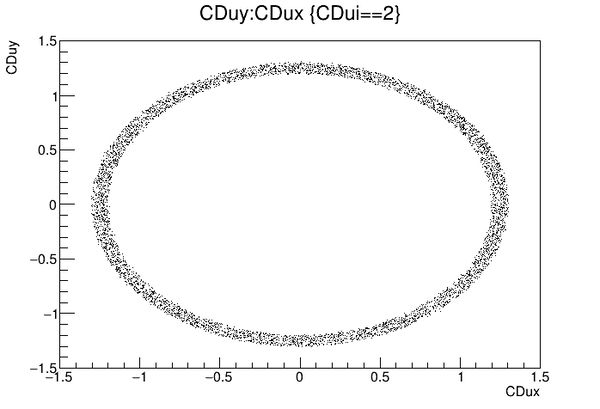
We can also look at a specific sector instead, using Draw("CDvy:CDvx","CDvj==2) we plot the second sector. (First sector is at \phi = 0 and counts counterclockwise.)
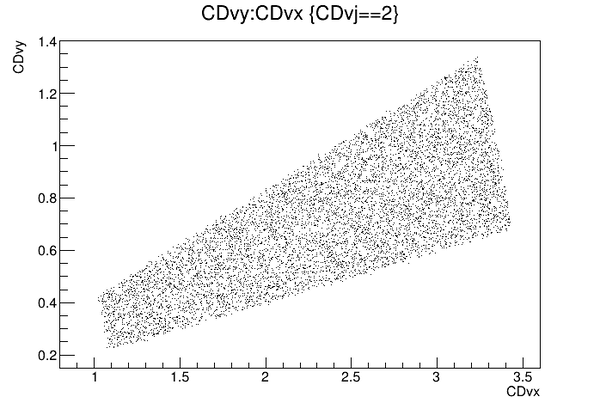 One might want to specify both a CDui and a CDvj at the same time. Sure enough, root will plot that for you but the events are stored separately in CDu and CDv so you need to be careful if you want the correct amount of hits to be displayed. By default in ggland, hits are sorted by decreasing energy. There is an option to simplify the output that is described further down.
One might want to specify both a CDui and a CDvj at the same time. Sure enough, root will plot that for you but the events are stored separately in CDu and CDv so you need to be careful if you want the correct amount of hits to be displayed. By default in ggland, hits are sorted by decreasing energy. There is an option to simplify the output that is described further down.
Digitizer for the CD Detector
If digi is specified in --tree, the ROOT tree will contain branches with "CDud" and "CDvd" prefixes. We can plot a histogram for all segments using Draw("CDudi") for the radial segments
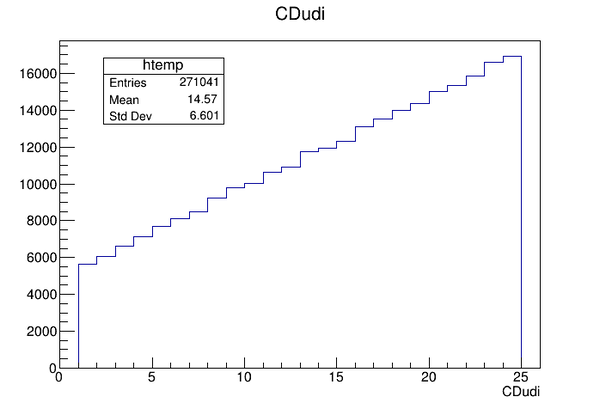
and Draw("CDvdi") to get a histogram for the phi segments. As the area of each ring increases further away from the origin we expect the counts to be higher for the CDudi, but the area is constant between sectors so the histogram for CDvdi looks quite boring.
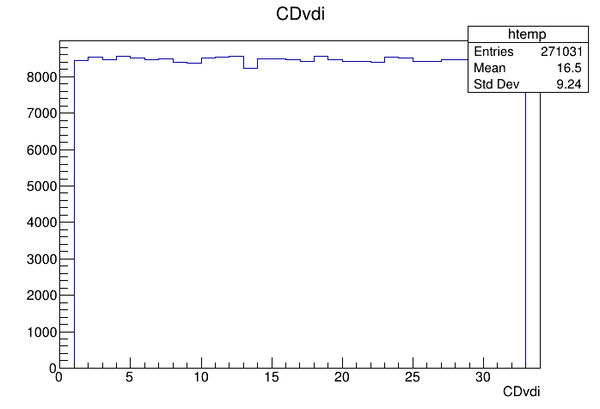 To emphasis the above statement about plotting with a condition on index from both CDu and CDv, the total amount of counts on these two histograms are not equal. If we want, we can of course plot the energies in each ring using Draw("CDude1:CDudi+rndm") to see the energy deposits on each ring. (The randomness (rndm) is just to spread the events along the x-axis.) Always check
To emphasis the above statement about plotting with a condition on index from both CDu and CDv, the total amount of counts on these two histograms are not equal. If we want, we can of course plot the energies in each ring using Draw("CDude1:CDudi+rndm") to see the energy deposits on each ring. (The randomness (rndm) is just to spread the events along the x-axis.) Always check
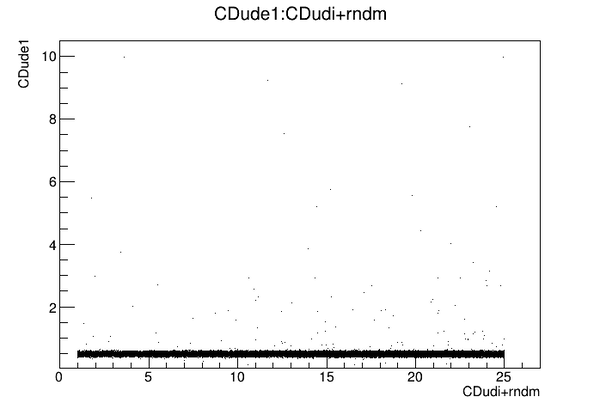
Simplified Output Tree
For some cases, having a separate event list for the radial and angular segments might be too much and this is where the simple option might be preferred. This will reduce the output to contain only CD (as opposed to CDu and CDv) and each hit will now have two indices, CDi and CDi2. This option does not include a digitizer as the output is not to use for analysis scripts and such, but is intended for some testing when you want a root tree with fewer branches. To use the simplified detector output, just add simple to the cd:
./land_geant4 --cd=z0=2cm,simple\
--gun=box,sdx=8cm,sdy=8cm,p,T=10MeV \
--world=type=vacuum --events=50000 \
--tree=test.root
So now we can condition on both a sector and a ring.
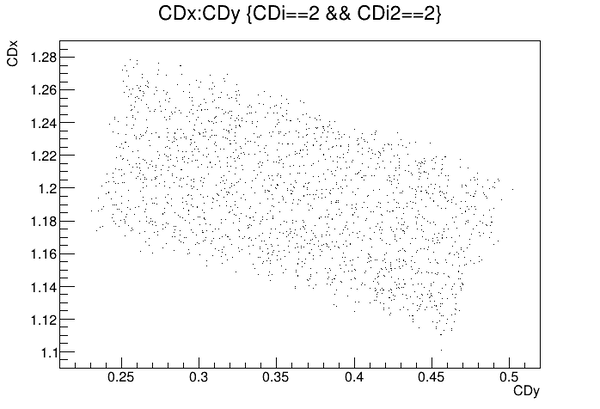
Changing Parameters from the Command Line
If you want to change a parameter of the CD detector it's easy to do so from the command line. During the Simplified Output Tree, we added the option simple to the cd argument: --cd=simple. In the examples given on this page, we've also placed the detector 2 cm away from the detector using --cd=z0=2cm. All parameters displayed in the cd help text in ggland are modifiable so we can go really crazy if we want. For instance --cd=z0=2cm,thickness=6um,deadlayer=1nm,type=C,enter will change the total thickness of the disc to 6 um (micrometer), having a deadlayer of 1 nm, using carbon instead of silicon and enter will include all incoming particles to the detector in the ROOT tree. Each parameter is separated with a comma and no special order is required.| I | Attachment | Action | Size | Date | Who | Comment |
|---|---|---|---|---|---|---|
| |
cd_22.png | manage | 15 K | 05 Apr 2024 - 14:14 | BjörnJohansson | |
| |
cd_2ring.png | manage | 15 K | 05 Apr 2024 - 11:58 | BjörnJohansson | |
| |
cd_2sector.png | manage | 23 K | 05 Apr 2024 - 11:58 | BjörnJohansson | |
| |
cd_all.png | manage | 29 K | 05 Apr 2024 - 11:50 | BjörnJohansson | |
| |
cd_digie.png | manage | 7 K | 05 Apr 2024 - 13:53 | BjörnJohansson | |
| |
cd_phihist.png | manage | 9 K | 05 Apr 2024 - 13:43 | BjörnJohansson | |
| |
cd_radhist.png | manage | 9 K | 05 Apr 2024 - 13:43 | BjörnJohansson | |
| |
cd_visual.png | manage | 37 K | 05 Apr 2024 - 11:16 | BjörnJohansson |
 Copyright © by the contributing authors. All material on this collaboration platform is the property of the contributing authors.
Copyright © by the contributing authors. All material on this collaboration platform is the property of the contributing authors. Ideas, requests, problems regarding Foswiki? Send feedback

